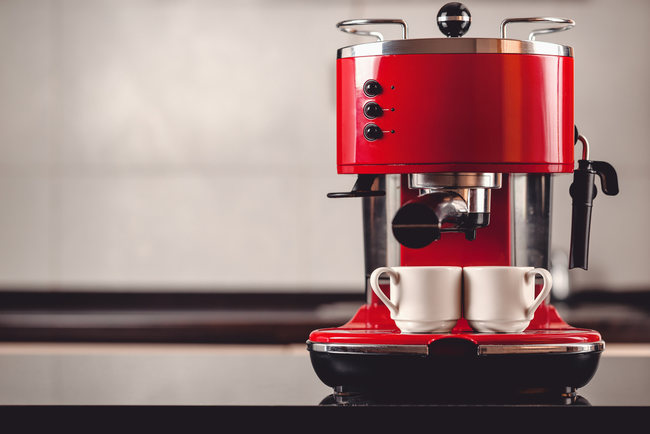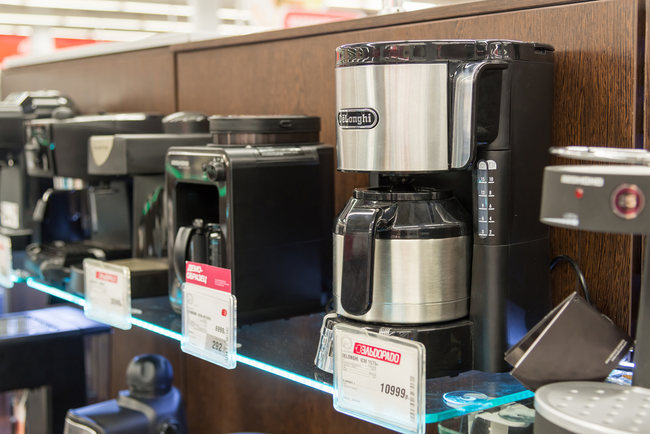Feb 12, 2020

How to Choose the Right Coffee Machine for Your Shop
You'd like to make an investment and open a coffee shop, but you don't know what kind of coffee machine you should use? We have some answers for you. Makro HoReca Academy will explain how to choose each kind of coffee machine and how each can be used so that the coffee shop owner can deliver fragrant coffee that impresses coffee lovers and turns them into regular customers.
How to Choose a Coffee Machine
Choosing a coffee machine is like choosing the heart of the shop. If you are opening a coffee shop, you need to understand the principles related to the machines that might be used. That's because, if you spend hundreds of thousands on a machine that doesn't work for its value or if it ends up being used infrequently, you would be wasting your investment. That's why we are giving you some recommendations on how to choose the right coffee machine for your shop.

- Machine Brand – Different coffee machine brands are manufactured by different countries. However, the most widely accepted country for its coffee machine production is undeniably Italy, with many other nations following such as Spain, America, Australia, and France.
- Working Characteristics of Coffee Machines – Most have relatively similar functions. That is, they use pressure to send heated water to a brewing unit, and controlling the temperature of water in the brewer is very important to every coffee machine. That's because the temperature used to make coffee is very important. That's why many different manufacturers use the best water temperature control technologies as the selling points for their machines. It's become a main factor in choosing coffee machines. However, there are also other factors such as the brewing system, prevention of excess heat, materials used to manufacture internal components and external structure; some models even feature display monitors or automatic control system or digital screen. All of these factors have been developed by the different brands to the point that they don't vary a great deal in terms of standards.

- Each Dealer's Services and Post-Sale Services – A coffee machine is an electrical appliance. Naturally, it has a usage life. Whether that life is long or short depends on the maintenance provided to users. As a result, it's important to check post-sale services such as warranty, whether 1 year or 2 years, and service time that doesn't exceed a few hours, availability of mechanics and parts, and, if a company has quite a bit of potential, the presence of service stations distributed throughout various regions to provide timely services, offers of backup machines for free while waiting for repairs, etc.
Popular coffee machines include the following:
Espresso Machine

An espresso machine is the most popular coffee machine used in coffee shops. The starting price for this kind of machine is in the thousands of baht but it can be as expensive as hundreds of thousands or even millions. The differences between the prices from thousands to hundreds of thousands are in design, attractiveness, coffee-making stability and usage functions.
Machine Working Principles – Hot water accompanied by steam pressure inside the pot is used to push water through ground coffee in order to extract concentrated and highly fragrant coffee.
What are the differences among the different types of espresso machines?
There are many types of espresso machines according to usage space and structure size. Based on working mechanisms, they can be divided into many different types such as by number of brewing units, machine size, boiler, pressure control, heating system and espresso system.
Types of Espresso Machines
1. Single Boiler Machines
These machines each have only a single boiler to make both espresso and steamed milk. The user has to select whether to extract espresso or steamed milk. That's because milk-steaming normally uses a higher temperature than espresso extraction due to the differences in the suitable temperatures for milk-steaming and espresso extraction. As a result, the user has to wait for the boiler to boil and reach the desired temperatures before use, which is definitely a disadvantage for this type of machine.
Some single-boiler coffee machines use a filter handle called a pressurized portafilter. This type of filter handle is designed to mimic the resistance present in regular filter handles where freshly-roasted coffee is ground and appropriately tamped. So when you make old coffee or coarsely ground coffee using a pressurized portafilter, the coffee will have an attractive crema.
We recommend an automatic coffee machine capable of making coffee by a single press of a button, where the coffee grinder will grind the coffee beans for extraction and mixing according to a desired recipe, and all that has to be done is add the beans and add the water. The power needed by this type of machine would be 1,200 watts, and it should have the ability to produce a special kind of steamed milk with automatic milk suction, cappuccino steamed milk and hot milk. Click to see an actual machine
2. Heat Exchange Boiler Machines
These machines have been developed from single-boiler machines. They still have only a single boiler each. However, a tube goes through the center of the boiler to function in exchanging the heat of water flowing through the tube and hot water inside the boiler. As a result, the water that flows through the tube is also hot. This water flowing through the tube will head to the group heads for espresso extraction, so the water inside the boiler is only used to steam milk. As a result, it's possible to extract espresso and steam milk at the same time without having to choose one over the other. One problem with this type of coffee machine, however, is that, if espresso is extracted continuously, water might not heat fast enough for use, so temperatures might be inconsistent, whether in the form of insufficiently hot water or excessively hot water due to having been left inside the tube for too long.
We recommend a traditional coffee machine for large coffee shops. It comes equipped with an ABM.07 system that can help maintain the amount and temperature of coffee water so that it stays consistent and so that it can produce perfect shots of espressos despite continuously coffee-making. The milk frother is also especially designed to easily, smoothly and swiftly froth milk, and the water level can be set automatically. Click to see an actual machine
3. Double Boiler Machines
This is an improvement from the heat exchange boiler machines. A double boiler machine has a separate boiler for steaming milk and a boiler for extracting espresso. As a result, it offers better temperature control for making coffee and steaming milk, and it's possible to continuously extract espresso with greater temperature stability. The only problem with this type of coffee machine is its price.
4. Heat Exchange Double Boiler Machines
These machines combine the advantages of double boiler and heat exchange machines. Water heading into the boilers for espresso extraction flows through the boilers for milk steaming, heating the water that enters the espresso extraction boilers. This helps increase the stability of boiler temperatures for espresso extraction even further.
5. Multi Boiler Machines
These are boiler systems found in large coffee makers with two boilers and above. Multi boiler machines with heat exchange feature a different boiler for each brewing unit, and large boilers for milk steaming. As a result, it is possible to set different temperatures for different brewing units for making different kinds of coffee.
Aside from other systems mentioned, there are also other necessary equipment that you need to consider such as PID and water pumps, along with the special specifications of certain machines or brands that allow the user to control other variables freely.
How to Choose the Right Coffee Machine for Your Shop
Which coffee machine size should you pick for your shop? Their sizes are different due to different boiler and equipment sizes. Large machines have larger boilers than smaller machines and so promise more continuous coffee making capabilities. That's because the larger boilers keep the coffee water temperature more stable while making coffee. There are three boiler sizes as described below.
- Small Coffee Makers (boiler size at 300 cm3) – This is for cases where your restaurant is located where only one or two customers visit at a time and not in large groups, and the time between the arrival of each customer is quite long (about 3-5 minutes).
We recommend a coffee machine featuring excellent innovations from Switzerland. With its elegant and neat design and advanced technology, it can make 16 different kinds of beverages. It has an LED display with a touch system for giving work instructions. Its recommended cups per day is 100 cups/day (single shot) Click to see an actual machine
- Medium Coffee Makers (boiler size about 1.3-2 liters) – This is for cases where your restaurant has customers arriving in groups of 3-5 people but there's a small gap between each group of customers (3-5 minutes).
- Large Boiler Machines (boiler size of 6.5 liters and above) – This is for cases where your customers visit all day long or arrive in large groups of 8-10 people or more, and there's almost no time for breaks.
We recommend a large coffee maker with high working effectiveness with emphasis on luxury. The machine should be easy to use and uncomplicated, suitable for coffee shops focused on high effectiveness with limited working space with quality guarantee. Coffee extraction is by a soft infusion system (SIS) to make perfect shots even more perfect, and milk froth steaming is achieved by the use of three lever-type milk frothers. Click to see an actual machine
How to Choose a Worthwhile Coffee Machine for Your Investment
- Selling Prices of Coffee
Of course, if you plan to sell your coffee within a price range of 25-45 baht, it's not necessary to invest in a highly expensive coffee machine, because doing so would only lengthen the break-even point.
- Coffee Machine Prices
Coffee machines suitable for investment for the fresh coffee market in Thailand are in the price range of 25,000-100,000 for 1-brewing-unit machines and 90,000-150,000 baht for 2-brewing-unit machines, and sometimes making a one-time investment on a good coffee machine when you could guarantee sales might save you a lot of investment money.

If you would like to create distinction and increase the value of your shop so that more people visit you, we recommend a coffee printer that uses food coloring mixes that can print using pictures sent by WIFI from iPhones/Android/tablet devices for customers. It takes only 15 seconds to print, and it's easy to use and offers a lot of fancy features. Customers can choose pictures that they can print themselves through 7" LCD touch-screen + WIFI connection. The printing cost is only 3 baht/ cup. We recommend it if you are looking for a tool to boost your sales. Click to see an actual machine
